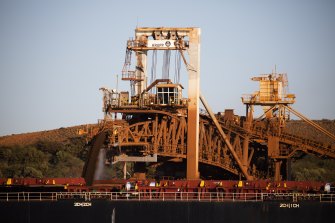‘Slow but sure’: Miners are looking for cleaner power as green shift heats up
The owner of Australia’s largest hybrid renewable microgrid says mining firms are increasingly pushing into cleaner power alternatives for their remote mine sites amid warnings that slashing emissions will be critical to their survival in a net-zero world.
In the face of intensifying pressure to combat global warming, companies across the industry including Rio Tinto, BHP and Fortescue have earmarked billions of dollars in the past two years to clean up their difficult-to-decarbonise mining operations by shifting away from fossil fuels like diesel and gas.

Distributed energy provider EDL, which built a 56-megawatt solar, wind and battery project to help power Western Australia’s Agnew gold mine, said the mining sector was making the “slow but sure transition to decabonisation”.
Ahead of his address at the International Mining and Resources Conference (IMARC) in Melbourne later this month, EDL chief executive James Harman said off-grid customers across remote Australia largely depended on diesel or gas-fuelled generation but were increasingly turning to hybrid solutions combining renewables with back-up gas or diesel to reduce their carbon footprint, improve reliability and keep a lid on costs.
“Our Agnew Hybrid Renewable Microgrid at Gold Fields’ Agnew Gold Mine provides the mine with energy that is an average of 50-60 per cent from renewable sources, with 99.99 per cent reliability,” he said.
With its use of five wind turbines, the microgrid, which officially opened in November, is the first project in the industry to power a mine predominately with wind-powered electricity.
Across Australia and around the world, the mining industry accounts for a huge share of planet-heating greenhouse gases, both from mining operations themselves and the emissions generated by the end use of the mined resources after they are sold to be burned or processed in factories and power plants. Mining companies have been under rising pressure to improve their carbon credentials, with powerful investors seeking to reduce their exposure to long-term risks posed by global warming, such as legislative changes, more frequent weather-related disasters and shifting consumer preferences for green technologies.
Nik Gresshoff, the head of mining at energy technology provider ABB Australia, said the challenge for mining firms was to “map out their own journey” and assess the gains that could be achieved through automation and other investments required to achieve their targets for net-zero emissions.
“The next step is to examine the technology and what is currently possible to decarbonise,” Mr Gresshoff said “Having a clear understanding of where the company assets are in their life cycle is critical, as well as an understanding of what technology is available and what technology could fit with the current operation.”
Rio Tinto, the nation’s biggest iron ore miner, last year vowed to lift its 2030 carbon-reduction targets from 15 per cent to 50 per cent across its global operations, and committed to spending $US7.5 billion ($10 billion) on decarbonisation investments by the end of the decade. It has an ambition for net-zero emissions — removing as much carbon dioxide from the atmosphere as it generates — by 2050.
“Governments are setting more ambitious targets and accelerating actions on climate change,” Rio said in October. “Society at large is also demanding companies take more action to decarbonise.”
A key part of Rio’s investments will be earmarked to clean up its sites in Australia, where iron ore output provides the bulk of the group’s earnings. Its sites are mainly powered by emissions-intensive gas-fired electricity and Rio said it would invest in building 1 gigawatt of new wind and solar power to help replace natural gas.
BHP has a target to cut its direct emissions by 30 per cent by 2030, and a goal for net-zero emissions by 2050. Fortescue, whose chairman and top shareholder is billionaire Andrew Forrest, has set the mining sector’s most aggressive decarbonisation pledges including a hard target to reach net-zero emissions across its existing and future operations by 2030.
Fortescue, which generates more than 2 million tonnes of greenhouse gas a year, has been trialling technology in hydrogen, ammonia and battery power for trains, ship engines, haul trucks and drill rigs in a bid to achieve its target.
Most Viewed in Business
Source: Thanks smh.com